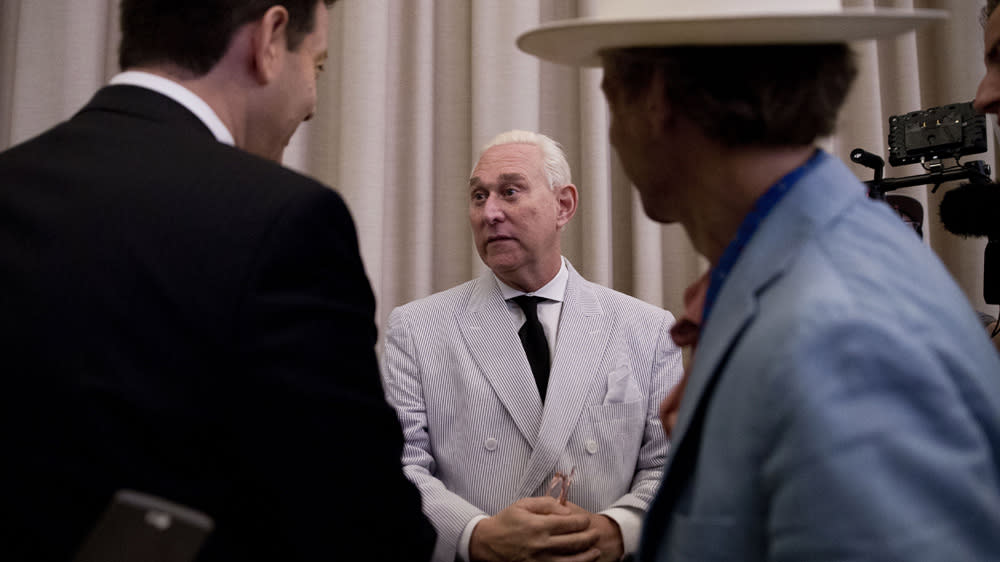PopPolitics: Roger Stone, the Link Between Nixon and Trump (Listen)

“Get Me Roger Stone,” a new Netflix documentary debuting this week, arrives at an opportune time.
Stone is the colorful, notorious political operator who once again was near the center of the news vortex with reports that he recommended to President Trump that he fire FBI Director James Comey. He says that he never claimed that.
Stone also denies that he had any links to Russian sources believed to be responsible for hacking into the Democratic National Committee and a top Clinton campaign official — and he has offered to testify before House and Senate intelligence committees.
As much as Stone may push back on these stories, it’s hard not to see just how much he likes and even thrives on being at the center of attention, even if it is at his own expense. He embraces the aura of a dirty trickster, “a sinister Forrest Gump,” as one person calls him, and the notion that it is better to be infamous than not known at all.
On the latest “PopPolitics,” Dylan Bank and Daniel DiMauro, who directed “Get Me Roger Stone” along with Morgan Pehme, talk about the making of their project. They land interviews not just with Trump campaign veteran Paul Manafort, himself facing questions about his Russian connections, and Trump himself, who calls Stone “a quality guy.”
As Bank and DiMauro explain, Stone seems to have a hot and cold relationship with Trump — and it is a bit unclear as to how much they still communicate. During the campaign, Stone was an official adviser until he abruptly left in August, 2015, but he is often quoted ever since in an unofficial capacity as a Trump loyalist.
The movie traces Stone’s role in a new kind of audacity in politics in recent decades — in particular, attack politics and a new kind of influence peddling — but most relevant this week may be how it shows how Stone is the link President Richard Nixon and President Donald Trump.
In the documentary, Stone recalls his work, when he was just 19, for the Nixon campaign in 1972. He had a hand in a dirty trick played on the campaign of Rep. Pete McCloskey (R-Calif.), a liberal Republican making a quixotic primary challenge against the incumbent president, and Stone’s work eventually landed him on a target list among Watergate investigators. As Stone recalls, when his name was thrust into the public sphere, his parents were “mortified.” “I thought it was pretty cool,” he said.
Stone says that he was instantly taken by Trump when they met in 1979, introduced by a mutual friend, Roy Cohn, made famous as the chief counsel to Sen. Joseph McCarthy (R-Wis.) during the Red Scare of the 1950s, but it wasn’t until later in the 1980s that Stone grasped the idea that the New York real estate developer could run for office. And it wasn’t even Stone who saw it.
“It was Richard M. Nixon who first noticed the potential for a presidential bid by Donald Trump,” Stone writes in his recent book “Making of the President 2016.”
As Stone recounts, in the late 1980s the former president, by then a friend, asked him to invite Trump and wife Ivana to join them for a weekend in Houston.
“Nixon was in rare form,” Stone writes. “He and Trump spoke privately for hours, with the New York real estate mogul peppering the former president with questions.” They had a mutual admiration, and Trump invited Nixon to fly back to New York with him on his 727.
“Had he lived to see the 2016 presidential race, Nixon would surely have savored the fearlessness and ferocity with which Trump routinely lambasted the mainstream media,” Stone writes.
As “Get Me Roger Stone” shows, though, it is much more than media bashing that unites Nixon and Trump — but the strategy of appealing to the Silent Majority by waging campaigns of law and order, resentment, and grievance. It’s not some great big revelation, as during the campaign Trump at times took to using Nixon’s phrasing to much success.
What’s much less flattering this week is that now there is a cascade of comparisons between Trump and the much darker side of Nixon — witness the use of the word “Nixonian” to describe the President’s decision to fire Comey. It’s a loaded term, but the latest Trump tweets hinting that he possesses recordings of his private conversations are just more fuel for making parallels between then and now.
Stone, who has a tattoo of Nixon on his back, sees a bit of treachery at work in the White House, adding a bit more intrigue as he is apt to do. He told reporters that he believes that the source of the stories about him pressing Trump to fire Comey “is someone in the President’s circle” who thought his longtime association with Nixon would bring “inevitable comparisons with the Saturday Night Massacre” and “thus discredit the option of firing Mr. Comey.”
Negative attention? There’s no such thing. On Friday, he was on “The View” to promote the documentary, to again make some news, and to be a bit outrageous. He invited Joy Behar to his place so he could show her the tattoo of Nixon on his back.
Get more from Variety and Variety411: Follow us on Twitter, Facebook, Newsletter
